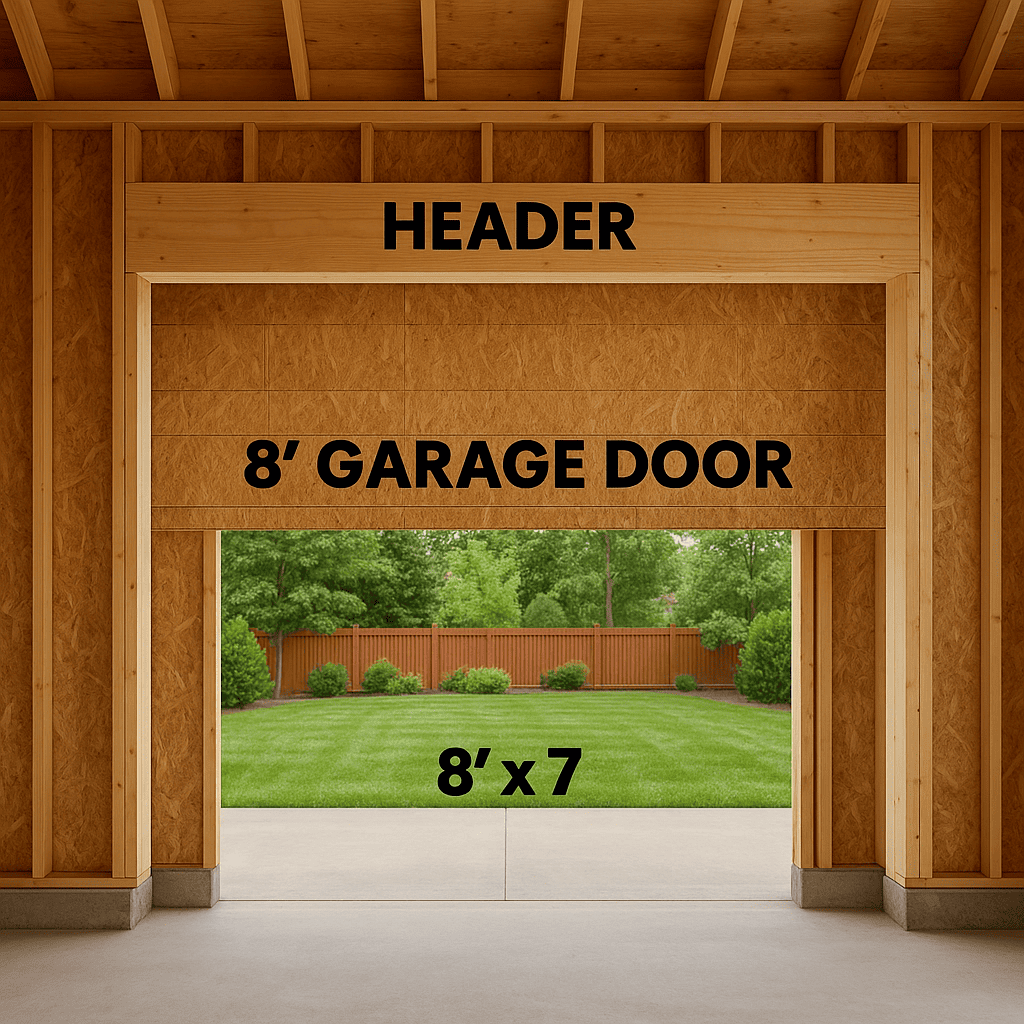Introduction
Planning to install or replace your garage door? One of the most overlooked yet crucial parts of the project is choosing the right 8′ garage door header size.
The header supports the weight above your garage opening — and using the wrong size can lead to structural issues or sagging.
Let’s go over everything you need to know to get it right the first time.
What Is a Garage Door Header?
A garage door header is the horizontal beam that sits above the garage door opening.
Its main job is to:
- Support the wall and roof load above the door
- Distribute weight evenly across the opening
- Keep the frame stable over time
In short, your header is the backbone of your garage door’s structure.
Standard 8′ Garage Door Header Size
When framing for an 8-foot-wide garage door, the header size depends on:
- The load type (single-story or two-story structure)
- The span width (door opening)
- The material used (wood, LVL, or steel)
Here are general guidelines most builders follow:
| Structure Type | Recommended Header Size | Material |
|---|---|---|
| Single-story garage | 2×10 or 2×12 wood header | Wood |
| Two-story garage | (2) 2x12s with ½” plywood spacer | Wood |
| Heavy load or long span | 1¾” x 11⅞” LVL or steel beam | Engineered lumber or steel |
Pro Tip: Always confirm your final size with a structural engineer or local building codes, since load requirements vary by region.
Factors That Affect Header Size
1. Load-Bearing Weight
If your garage supports a second story, you’ll need a thicker and stronger header to handle the added weight.
2. Material Choice
- Wood headers are affordable but bulkier.
- LVL (Laminated Veneer Lumber) beams offer high strength with less depth.
- Steel headers are ideal for heavy-duty or commercial garages.
3. Door Width
Even within 8-foot openings, small design variations can impact header requirements. Always measure the rough opening accurately before cutting or framing.
Step-by-Step Guide: Framing for an 8′ Garage Door
Step 1: Measure and Mark
- Mark the width of the door opening (8 feet).
- Add 1½ inches on each side for trimmers or jack studs.
Step 2: Cut the Header
- Cut two pieces of 2×12 lumber and a piece of ½” plywood.
- Sandwich the plywood between the two boards and nail them together.
Step 3: Install the Frame
- Place the assembled header on top of the jack studs.
- Check for level alignment before securing it.
- Add cripple studs above the header for stability.
Step 4: Double-Check Measurements
Make sure the rough opening matches your door manufacturer’s specifications — usually 8′ wide x 7′ high.
Example: LVL Header for an 8′ Door
For a modern garage with a heavier roof load, you might use:
- (1) LVL beam – 1¾” x 9½” or 1¾” x 11⅞”
These beams are lightweight, stronger than standard lumber, and minimize deflection over time.
Safety and Building Code Tips
- Always follow local building codes for load-bearing walls.
- Use approved fasteners and brackets.
- Hire a licensed contractor for installations involving second-story loads.
Improper header sizing can cause serious structural damage or failure — don’t take shortcuts here.
Suggested YouTube Video
Watch: How to Frame a Garage Door Opening Correctly
Channel: Home RenoVision DIY
This video shows step-by-step framing techniques for garage door headers, including LVL beam installation.
FAQs About 8′ Garage Door Header Size
1. What size header do I need for an 8-foot garage door?
For most single-story garages, a double 2×10 or 2×12 header is sufficient. If the wall carries extra weight (like a second floor), use an LVL or steel header.
2. Can I use a 4×12 header for an 8′ garage door?
Yes, in light-load situations, a 4×12 solid wood beam can work. However, always check local code requirements before using a single board header.
3. Do LVL beams need support posts?
Usually not for 8-foot spans. LVLs are engineered to handle heavy loads across shorter openings without additional supports.
Conclusion
Choosing the right 8′ garage door header size isn’t just about measurements — it’s about safety, longevity, and stability.
A properly sized and installed header prevents sagging, cracking, and costly repairs later on.
If you’re unsure, consult a structural engineer or professional installer before cutting or framing. It’s a small step that ensures a strong, durable garage structure for years to come.
Ready to start your project? Get accurate measurements, choose the right header, and enjoy peace of mind knowing your garage is built to last.




